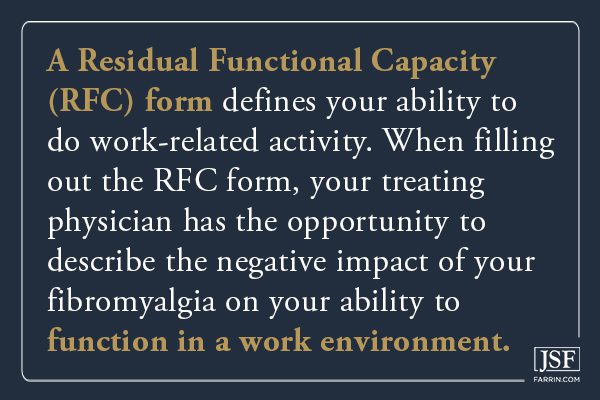Fibromyalgia is a complicated condition that involves widespread muscle pain and tenderness. People suffering from this disorder also often have issues with fatigue, sleep, mood, and memory. Because fibromyalgia is somewhat of an invisible illness with few observable symptoms, people with it often experience frustration in gaining acknowledgment of their ailment from others. It can affect relationships, as well as upset the balance in one’s life.
Your pain and symptoms may also impact your ability to work and earn income. Is that enough for you to be eligible for Social Security Disability benefits?
Until the Social Security Administration (SSA) published a policy interpretation ruling on fibromyalgia in 2012, many Social Security Disability benefit claims for people with the syndrome were denied. In this article, I will explain how the SSA approaches fibromyalgia claims today, and how you can improve your chances of receiving Disability benefits if you have it.
Is Fibromyalgia a disability in terms of Social Security?
Simply put, yes it can. But that does not mean it’s simple. Fibromyalgia is not listed in the SSA’s Disability Evaluation Under Social Security guidelines, (also known as the Blue Book). However, in 2012, the agency published a detailed ruling to “provide guidance on how we develop evidence to establish that a person has a medically determinable impairment (MDI) of fibromyalgia (FM) and how we evaluate FM in Disability claims and continuing Disability review.”
This ruling has helped some individuals struggling with fibromyalgia successfully claim Disability benefits, but the process is still complicated. Receiving a diagnosis of fibromyalgia does not automatically qualify you for Social Security Disability benefits. An experienced Social Security Disability attorney can help you navigate the process and submit an accurate and complete claim.
Which Social Security Disability Benefits Can You Get for Fibromyalgia: SSDI or SSI?
If you have fibromyalgia, you can apply for Social Security Disability Insurance (SSDI) benefits or Supplemental Security Income (SSI) benefits.
- To obtain SSDI, you must meet the medical criteria for having fibromyalgia, as well as the SSA’s work credit requirement. The number of work credits you need depends of how old you were when you became disabled with fibromyalgia.
- To receive SSI, you must meet the SSA’s limited income/asset/resource threshold, as well as the medical criteria for fibromyalgia.
Talk with an attorney to see if you meet the requirements for receiving SSDI or SSI benefits for your fibromyalgia.
What Proof of Disability Does the Social Security Administration Require for Fibromyalgia?
The SSA requires sufficient medical evidence that establishes fibromyalgia as a “medically determinable” impairment. Generally, it will review at least a year’s worth of medical records and doctor evaluations of your fibromyalgia. Your attorney can help you submit the results of the right diagnostic tests and documentation of all medications, therapies, and lifestyle remedies prescribed to treat your fibromyalgia symptoms.
The SSA may also request evidence from psychologists and other medical sources, as well as from non-medical sources such as past employers and neighbors, to establish the credibility of your symptom allegations. For example, your employer may be required to show that you have missed a significant amount of time from work because of the severity of your symptoms.
Consult with an experienced Disability attorney before making your fibromyalgia Disability claim. You don’t want to set your case back by saying the wrong thing. Call our office at 1-866-900-7078 or visit online for a free case evaluation.
How Can You Establish that Fibromyalgia is an MDI?
For fibromyalgia to be considered an MDI, a patient must have relevant medical records that show:
1) history of widespread pain for 3 months – the pain can fluctuate in intensity and does not have to be consistently present
2) evidence that rules out that other disorders could have caused the symptoms and signs
3a) at least 11 positive tender points on physical examination – these must be found on both the left and right sides of the body and both above and below the waist OR
3b) repeated manifestations of six or more FM symptoms, signs, or co-occurring conditions – especially fatigue, depression, anxiety disorder, cognitive or memory problems, irritable bowel disorder, or waking unrefreshed
If the SSA agrees that your fibromyalgia is an MDI, you will have to prove that the condition prevents you from doing any type of work on a full-time basis. An SSD attorney can help you here, as well, and may advise you to ask your health provider to complete a Residual Functional Capacity (RFC) assessment. An RFC can be pivotal in proving that you are unable to work substantially.
How Do I Apply for Fibromyalgia Disability Benefits?
You can apply for your fibromyalgia Disability benefits at the nearest SSA office as soon as you become disabled. You can also complete you application online or call the SSA on their toll free number: 1-800-772-1213.
You will need to prove that the symptoms of fibromyalgia prevent you from working, which requires specific details about your medical history and the pain and sensitivities you encounter due to the disorder. Consult with an attorney to see how you can strengthen your claim for Social Security Disability benefits for fibromyalgia.
Get Help With Your Disability for Fibromyalgia Social Security Claim
Although proving that you are disabled and unable to work due to fibromyalgia can be difficult, working closely with your doctors and a qualified Disability attorney to collect and present supporting documentation can help improve the chances of success for your fibromyalgia Disability case.
I have been helping clients file Disability claims and appeal claim denials for more than 20 years. My team would be honored to help you. Call 1-866-900-7078 today for a free case evaluation.





